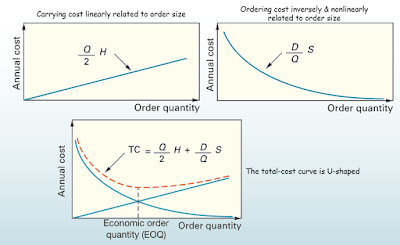Inventory planning & control
A stock or store of goods
- The stored accumulation of material resources in a transformation system
- Allow the flexibility
- Exceptional quality
- Give a level of dependability
- Better return on investment (ROI)
Functions of Inventory
- To meet anticipated customer demand
- To smooth production requirements
- To protect against stock outs & take advantage of order cycles
- To hedge against price increases
- To permit operations
- To take advantage of quantity discounts
Types of inventory
- Buffer inventory (safety inventory)
- Purpose is to compensate for the unexpected fluctuations in supply & demand
- Cycle inventory
- One or more stages in the process can't supply all produced items simultaneously
- Decoupling Inventory
- Allows each operation to be set to the optimum processing speed
- Pipeline inventory
- Goods-in-transit to warehouses, distributors, or customers
- Raw materials & purchased parts
- Work-in-process (WIP)
- Finished-goods inventories
- Maintenance & repairs (MRO) inventory
Objectives of Inventory Control
Although inventory plays an important role, there are a
number of negative aspects
- Inventory ties up money, in the form of working capital
- Inventory incurs storage costs (leasing space, maintaining appropriate conditions)
- Inventory may become obsolete as alternatives become available
- Inventory can be damaged, or deteriorate
- Inventory could be lost, or be expensive to retrieve
- Inventory might be hazardous to store & require special facilities
- Inventory uses space that could be used to add value
- Inventory involves administrative & insurance costs
Inventory turnover: Ratio of average cost of goods
sold to average inventory investment
- A widely used performance measures to judge the effectiveness of inventory management
Requirements for effective inventory management
Management has two basic functions concerning inventory
- To establish a system to keep track of items in inventory
- To make decisions about how much & when to order
- A system to keep track of the inventory on hand & on order
- A reliable forecast of demand that includes an indication of possible forecast error
- Knowledge of lead times & lead time variability
- Reasonable estimates of inventory holding costs, ordering costs, & shortage costs
- A classification system for inventory items
Inventory Counting Systems
- Periodic system: Physical count of items in inventory made at periodic intervals (weekly, monthly)
- Perpetual inventory system: Keeps track of removals from inventory continuously, thus monitoring current levels of each item
- Two-bin system: Two containers of inventory; reorder when the first is empty
Inventory Costs
Basic costs which associated with inventories are as follows
- Purchase cost
- The amount paid to buy the inventory
- Holding or carrying cost
- Cost to carry an item in inventory for a length of time, usually a year
- Transaction or ordering cost
- Costs of ordering & receiving inventory
- Setup costs
- The costs involved in preparing equipment for a job
- Shortage cost
- Costs resulting when demand exceeds the supply of inventory; often unrealized profit per unit
- Obsolescence costs
- There is a risk that the items might either become obsolete (change in fashion) or deteriorate with age (foodstuffs)
Inventory priorities ( ABC system)
Classifying inventory according to some measure of
importance (usually annual dollar value), & allocating control efforts
accordingly
Typically, three classes of items are used
- A (very important), B (moderately important), & C (least important)
A item generally (10-20) % of total inventory but (60-70) %
of total annual dollar value
On the other hand, C item might account about (50-60) %
total inventory but only about (10-15) % of the dollar value of an inventory
cost.
These percentages vary from firm to firm
Steps to solve an A-B-C problem
- For each item, multiply annual volume by unit price to get the annual dollar value
- Arrange annual dollar values in descending order
- The few (10-15)% with the highest annual dollar value are A items. The most about 50% with the lowest annual dollar value are C items. Those in between about 35% are B items
Economic order quantity (EOQ)
The order size that minimizes total annual cost
- Find the best balance between the advantages & disadvantages of holding stock
- Find a fixed order size that minimize annual cost of holding & ordering inventory
Holding costs are including
- Working capital costs
- Storage costs
- Obsolescence risk costs
Order costs are including
- Cost of placing the order
- Price discount costs
Reorder point (ROP)
When the quantity on hand of an item drops to this amount,
the item is reordered
ROP = d × LT (Where, d = demand rate & LT = Lead time in days or weeks)
Safety stock: Stock that is held in excess of
expected demand due to variable demand &/or lead time
Safety stock reduces risk of stock out during lead time
Determinants of the reorder point quantity
- The rate of demand (based on a forecast)
- The lead time
- The degree of stock out risk acceptable to management
- The extent of demand &/or lead time variability





No comments:
Post a Comment